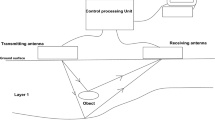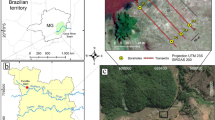Abstract
The use of Ground-Penetrating Radar as a tool for monitoring urban soils contaminated with road salt was tested. Data obtained from GPR measurements were compared with the results of laboratory analyses of soil samples collected during selected measurements and evaluated in relation to weather (esp. temperature and precipitation sums) prevailing prior to the individual measurements. It was proved that GPR technology can be used to indicate presence of road salt in soil to a certain extent. However, the radar also reacted sensitively to other irregularities within soil horizons such as type of soil freezing and thawing, changes in soil moisture content and probably also varying activity of soil biota. Further research is necessary to screen out these influences in order to improve practical applicability of this technology in research of soil salinity in urban environment.





Similar content being viewed by others
References
Ae N, Arihara J, Okada K, Srinivasan A (eds) (2001) Plant nutrient acquisition. New perspectives, 1st edn. Springer, Berlin
Asprion U, Aigner T (1999) Towards realistic aquifer models: three-dimensional georadar surveys of quaternary gravel deltas (Singen basin, SW Germany). Sediment Geol 129:281–297
Bäckström M, Karlsson S, Bäckman L, Folkeson L, Bo L (2004) Mobilisation of heavy metals by deicing salts in a roadside environment. Water Res 38:720–732
Bastviken D, Thomsen F, Svensson T, Karlsson S, Sandén P, Shaw G, Matucha M, Öberg G (2007) Chloride retention in forest soil by microbial uptake and by natural chlorination of organic matter. Geochim Cosmochim Acta 71:3182–3192
Bollag J, Stotzky G (1990) Soil Biochemistry. Volume 6. Martin Dekker, New York
Castellaro S, Imposa S, Barone F, Chiavetta F, Gresta S, Mulargia F (2008) Georadar and passive seismic survey in the roman amphitheatre of Catania (Sicily). J Cult Herit 9:357–366
Cekstere G, Osvalde A (2013) A study of chemical characteristics of soil in relation to street trees status in Riga (Latvia). Urban For Urban Gree 12:69–78
Chen Y, Day SD, Wick AF, Strahm BD, Wiseman PE, Daniels WL (2013) Changes in soil carbon pools and microbial biomass from urban land development and subsequent post: development soil rehabilitation. Soil Biol Biochem 66:38–44
Cranny A, Harris NR, White NM, Barrett-Lennard E, Coles N, Rivers M, Smettem K, Wu J (2012) Screen-printed potentiometric sensors for chloride measurement in soils. Procedia Eng 47:1157–1160
Cresser MS, Killham K, Edwards T (1993) Soil chemistry and its implications. Cambridge University Press, UK
Dai HL, Zhang KL, Xu XL, Yu HY (2012) Evaluation on the effects of deicing chemicals on soil and water environment. Procedia Environ Sci 13:2122–2130
Dolman AJ, Hall AJ, Kavvas ML, Oki T, Pomeroy JW (eds) (2001) Soil-vegetation-atmosphere transfer schemes and large-scale hydrological models, 1st edn. International Association of Hydrological Sciences, Wallingford
Doolittle J, Zhu Q, Zhang J, Guo L, Lin H (2012) Geophysical investigations of soil – Landscape architecture and its impacts on subsurface flow. In: Hydropedology: Synergistic integration of soil science and hydrology, 1st edn. Academic Press, pp 413–447
Golley FB (1993) A history of the ecosystem concept in ecology: More than the sum of the parts, 1st edn. Yale University Press, New Haven
Green SM, Machin R, Cresser MS (2008) Effect of long-term changes in soil chemistry induced by road salt applications on N-transformations in roadside soils. Environ Pollut 152:20–31
Gryndler M, Rohlenová J, Kopecký J, Matucha M (2008) Chloride concentration affects soil microbial community. Chemosphere 71:1401–1408
Harris JR, Day SD, Kane B (2008) Nitrogen fertilization during planting and establishment of the urban forest: a collection of five studies. Urban For Urban Gree 7:195–206
Hartley W, Uffindell L, Plumb A, Rawlinson HA, Putwain P, Dickinson NM (2008) Assessing biological indicators for remediated anthropogenic urban soils. Sci Total Environ 405:358–369
Holliger K, Maurer H (2004) Effects of stochastic heterogeneity on ray-based tomographic inversion of crosshole georadar amplitude data. J Appl Geophys 56:177–193
Howard KWF, Maier H (2007) Road de-icing salt as a potential constraint on urban growth in the greater Toronto area, Canada. J Contam Hydrol 91:146–170
Huisman JA, Sperl C, Bouten W, Verstraten JM (2001) Soil water content measurements at different scales: accuracy of time domain reflectometry and ground-penetrating radar. J Hydrol 245:48–58
ISO/DIS 10390 (1992) Soil quality - Determination of pH. International Organization for Standardization
IUSS Working Group WRB (2006) World Reference Base for Soil Resources 2006, 2nd edn. World Soil Resources Report 103, FAO, Rome
Jin L, Whitehead P, Siegel DI, Findlay S (2011) Salting our landscape: an integrated catchment model using readily accessible data to assess emerging road salt contamination to streams. Environ Pollut 159:1257–1265
Kalra YP, Maynard DG (1991) Methods manual for forest soil and plant analysis. Information report NOR-X-319. Forestry Canada, Northwest Region, Northern Forestry Centre, Edmonton, Alberta. Ministry of Supply and Services, Canada
Konijnendijk CC (2003) A decade of urban forestry in Europe. Forest Policy Econ 5:173–186
Lai WL, Kou SC, Poon CS (2012) Unsaturated zone characterization in soil through transient wetting and drying using GPR joint time: frequency analysis and grayscale images. J Hydrol 452–453:1–13
Linder S, Paasche H, Tronicke J, Niederleithinger E, Vienken T (2010) Zonal cooperative inversion of crosshole P-wave, S-wave, and georadar traveltime data sets. J Appl Geophys 72:254–262
Lorenz K, Lal R (2009) Biogeochemical C and N cycles in urban soils. Environ International 35:1–8
Lundmark A, Jansson PE (2009) Generic soil descriptions for modelling water and chloride dynamics in the unsaturated zone based on Swedish soils. Geoderma 150:85–95
McKenzie NJ, Ryan PJ (1999) Spatial prediction of soil properties using environmental correlation. Geoderma 89:67–94
Mummery D, Battaglia M, Beadle CL, Turnbull CRA, McLeod R (1999) An application of terrain and environmental modeling in a large-scale forestry experiment. Forest Ecol Manag 118:149–159
Orlando L (2003) Semiquantitative evaluation of massive rock quality using ground penetrating radar. J Appl Geophys 52:1–9
Orlando L, Soldovieri F (2008) Two different approaches for georadar data processing: a case study in archaeological prospecting. J Appl Geophys 64:1–13
Poudyal NC, Siry J, Bowker JM (2011) Urban forests and carbon markets: Buyers’ perspectives. J Forest 109:378–385
Pozdnyakova L, Pozdnyakov A, Zhang R (2001) Application of geophysical methods to evaluate hydrology and soil properties in urban areas. Urban Water 3:205–216
Rejšek K (1999) Forest soil science. In Czech, 1st edn. Mendel University, Brno
Rose CW (2004) An introduction to the environmental physics of soil, water and watersheds, 1st edn. Cambridge University Press, Cambridge
Schulze ED, Beck E, Müller-Hohenstein K (2005) Plant Ecology, 1st edn. Springer, Berlin
Schwamborn G, Heinzel J, Schirrmeister L (2008) Internal characteristics of ice-marginal sediments deduced from georadar profiling and sediment properties (Brøgger Peninsula, Svalbard). Geomorphology 95:74–83
Smith KA, Cresser MS (2004) Soil and environmental analysis : modern instrumental techniques, 3rd edn. Martin Dekker, New York
Steelman CM, Endres AL (2009) Evolution of high-frequency ground-penetrating radar direct ground wave propagation during thin frozen soil layer development. Cold Reg Sci Technol 57:116–122
Stein A, Ettema C (2003) An overview of spatial sampling procedures and experimental design of spatial studies for ecosystem comparisons. Agric Ecosys Environ 94:31–47
Szalai S, Lemperger I, Pattantyús-Ábrahám M, Szarka L (2011) The standardized pricking probe surveying and its use in archaeology. J Archaeol Sci 38:175–182
Takahashi K, Preetz H, Igel J (2011) Soil properties and performance of landmine detection by metal detector and ground-penetrating radar: soil characterisation and its verification by a field test. J Appl Geophys 73:368–377
Tinelli C, Ribolini A, Bianucci G, Bini M, Landini W (2012) Ground penetrating radar and palaeontology: the detection of sirenian fossil bones under a sunflower field in Tuscany (Italy). Comptes Rendus Palevol 11:445–454
van der Putten WH (1997) Plant-soil feedback as a selective forece. Trends Ecol Evol 12:169–170
Vičanová M, Toman F, Masíček T, Oppeltová P (2011) Comparative study of soil infiltration capacity at selected sites. Infrastruktura Ecol Rural Areas 12:17–30
Vrščaj B, Poggio L, Marsan FA (2008) A method for soil environmental quality evaluation for management and planning in urban areas. Landsc Urban Plan 88:81–94
Zbíral J, Honsa I, Malý S, Ciznar D (2011) Soil analysis, Part III, 2nd edn. In Czech. Central Institute for Supervising and Testing in Agriculture, Brno
Acknowledgments
This study was supported by project CZ.1.07/2.400/31.0032 (EE2.4.31.0032EE) ABIONET - The Platform for A Cooperation in A Landscape Formation.
Author information
Authors and Affiliations
Corresponding author
Rights and permissions
About this article
Cite this article
Rejšek, K., Hruška, J., Kuba, L. et al. A methodological contribution to use of Ground-Penetrating Radar (GPR) as a tool for monitoring contamination of urbansoils with road salt. Urban Ecosyst 18, 169–188 (2015). https://doi.org/10.1007/s11252-014-0391-y
Published:
Issue Date:
DOI: https://doi.org/10.1007/s11252-014-0391-y




